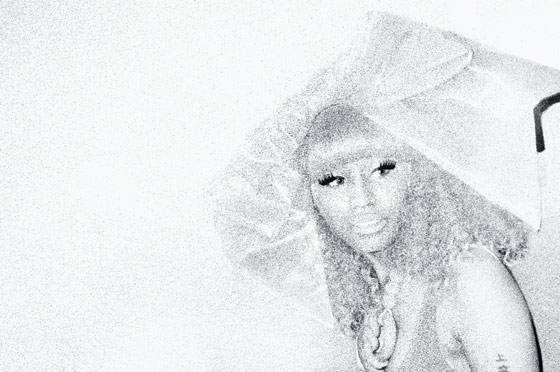 |
(Photo: Pari Dukovic) |
Nicki Minaj is five-foot-four, most of it in the gun-barrel thighs. In her bouncy cameo at Madonna’s sleepy Super Bowl show, Minaj lit up, looking like the anime villain of Madonna’s musical generation and the outlandish hero of her own—a threat to grind her gonzo godmother between those thighs like eggbeaters.
Minaj is the first great rapper to have made her name as a kind of hip-hop pinup—just as much, and maybe more, with her strut, her swag, and her loudmouth-in-outer-space style as by what she sounds like or what she says. (Though she does say a lot of really fantastic things, like, famously, “First things first I’ll eat your brains,” and “I only stop for pedestrians / Or a real, real bad lesbian.”) And it’s no coincidence she’s also the first woman to make a legitimate case for herself as hip-hop’s top dog. Or that doing it, as a woman, has meant turning herself into a doll-eyed candy-colored chameleon, converting talk shows and red carpets into manga strips with impossibly dyed, sometimes dichromatic wigs and a mind-bending array of improbably flattering gear—asymmetric sculptural gowns, patchwork-quilt skirts, and patterned one-piece jumpsuits that hide absolutely nothing. Shape-shifting is a survival mechanism for a lady in rap: If you stay in one place, the latent male aggression will gut you like a fish. Just ask Nicki’s sex-queen soul sister Lil’ Kim—or don’t, since as far as Kim is concerned, Minaj is an ungrateful plagiarist.
Since Minaj first showed up on raucous mixtapes in 2007, she has been a flipbook look book of slipstream identity and schizoid style, besting her Young Money mentor Lil Wayne at his own out-of-the-box game by doing it always with flirtatious glee. One of the hottest things about Minaj is how she cuts so quickly, in her lyrics and her outfits, from hard-edged supra-masculine to soft-focus and girlie: Her single-factory studio debut, 2010’s Pink Friday, was assembled out of hooks and built to charm, and she promises her second album, due in April, will be a great, angry leap forward, packed to bursting with character wizardry and virtuoso content. In the meantime, she’s kept building her stable of alter-ego thoroughbreds—Nicki Mirage; Nicky Lewinsky; Rosa; Roman Zolanski and his weirdly British mother, Martha Zolanski—all of whom parade through the pastel schizopolis of her bizarro music-video universe. And all of whom are dressed to the nines, in an à la carte assemblage of Cyndi Lauper gone cyberpunk, sexed-up Missy Elliott, black-light anime, Japanese street fashion, and hip-hop booty mag. Among a laundry pile of other influences from the anything-goes fashion future.
The whole circus is dazzling and code-cracking genius, since pop markets run by the same laws as any other: grow or die. The problem of being sexy in rap has forced all of Minaj’s flummoxed emcee predecessors the other way, into little whirlpools of self-caricature. (See, along with Kim and Elliott, MC Lyte, Da Brat, and Foxy Brown.)
With Nicki, the slideshow sequence of caricatures is so blinding you lose sight of the person doing the puppet-mastering. And stop caring: In a music culture built by a decades-long authenticity arms race, she makes you forget, finally, the essentialist question. Who Nicki is is much less important than what she is, which is really famous.
The references to forebears are there, though, in the clothes and in the brag: Kim and Missy and Left-Eye, Madonna, Grace Jones, Gwen Stefani, Britney Spears, Janet Jackson. All those women were also, and maybe unavoidably, style icons as much as musicians—Madonna especially, her own shape-shifting a kind of street-fashion fable that echoed down the generations: Anyone could be a star if you wanted it bad enough.
But the incredible thing about Nicki’s fantastical crystal-ball fairy tale is how little street is in it—impossibly little. The luxe polish is especially remarkable because she did grow up relatively rough, in a broken home her father once tried to burn down in Jamaica, Queens, from where she commuted to high school at La Guardia not for music (she didn’t make the cut) but for theater.
Minaj didn’t make her name right away—she’s 29 now and spent the first years out of school waitressing at Red Lobster, working in customer service and trying to hustle up label interest with some bottom-feeder New York crews. But when she did, parlaying a MySpace following into a mentorship with Wayne, she did it as theater, looking like an imperious kid whose entire one-woman show was conceived in a hall-of-mirrors prop room and costume shop: A gangbanger becomes a sex goddess becomes a flirty girl in a princess dress, sometimes in the space of a single guest verse, sometimes within a single staccato bar.

